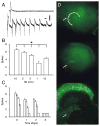Homeostatic plasticity in hippocampal slice cultures involves changes in voltage-gated Na+ channel expression
- PMID: 14751586
- PMCID: PMC2807128
- DOI: 10.1016/j.brainres.2003.11.035
Homeostatic plasticity in hippocampal slice cultures involves changes in voltage-gated Na+ channel expression
Abstract
Neurons preserve stable electrophysiological properties despite ongoing changes in morphology and connectivity throughout their lifetime. This dynamic compensatory adjustment, termed 'homeostatic plasticity', may be a fundamental means by which the brain normalizes its excitability, and is possibly altered in disease states such as epilepsy. Despite this significance, the cellular mechanisms of homeostatic plasticity are incompletely understood. Using field potential analyses, we observed a compensatory enhancement of neural excitability after 48 h of activity deprivation via tetrodotoxin (TTX) in hippocampal slice cultures. Because activity deprivation can enhance voltage-gated sodium channel (VGSC) currents, we used Western blot analyses to probe for these channels in control and activity-deprived slice cultures. A significant upregulation of VGSCs expression was evident after activity deprivation. Furthermore, immunohistochemistry revealed this upregulation to occur along primarily pyramidal cell dendrites. Western blot analyses of cultures after 1 day of recovery from activity deprivation showed that VGSC levels returned to control levels, indicating that multiple molecular mechanisms contribute to enhanced excitability. Because of their longevity and in vivo-like cytoarchitecture, we conclude that slice cultures may be highly useful for investigating homeostatic plasticity. Furthermore, we demonstrate that enhanced excitability involves changes in channel expression with a targeted localization likely profound transform the integrative capacities of hippocampal pyramidal cells and their dendrites.
Figures



References
-
- Bahr BA. Long-term hippocampal slices: a model system for investigating synaptic mechanisms and pathological processes. J Neurosci Res. 1995;42:294–305. - PubMed
-
- Bahr BA, Kessler M, Rivera S, Vanderklish PW, Hall RA, Mutneja MS, Gall C, Hoffman KB. Stable maintenance of glutamate receptors and other synaptic components in long-term hippocampal slices. Hippocampus. 1995;5:425–439. - PubMed
-
- Beal MF. Role of excitotoxicity in human neurological disease. Curr Opin Neurobiol. 1992;5:657–662. - PubMed
-
- Bien A, Seidenbecher CI, Bockers TM, Sabel BA, Kreutz MR. Apoptotic versus necrotic characteristics of retinal ganglion cell death after partial optic nerve injury. J Neurotrauma. 1999;16:153–163. - PubMed
-
- Brodie C, Sampson SR. Effects of ethanol on voltage-sensitive Na-channels in cultured skeletal muscle: up-regulation as a result of chronic treatment. J Pharmacol Exp Ther. 1990;255:1195–1201. - PubMed
Publication types
MeSH terms
Substances
Grants and funding
LinkOut - more resources
Full Text Sources

